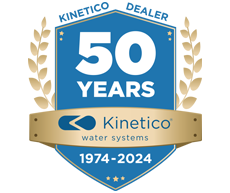One of the many unique features of Kinetico water softener systems is that they are powered by kinetic energy, which is effective in reducing energy cost. However, like other water softeners, Kinetico water softeners still utilize brine tanks and salt. Therefore, it is crucial to make sure you properly clean and maintain your water softener on a regular basis to minimize the dirt and sediment in your water lines and extend the overall lifespan of your system.
How Water Softeners Work
Water softener systems can malfunction over time for a few simple reasons. Before we get into the maintenance and repairs of water softener systems, let’s review how a Kinetico water softener system actually works.
Hard water is water which contains high levels of calcium and magnesium. Kinetico water softener systems contain resin beads that hold sodium ions. Once hard water passes through these resin beads inside your water softener, the resin beads hold onto the calcium and magnesium in exchange for sodium. Once this exchange process is complete, the water exits the softener system and is now soft.
Over time the resin beads become loaded with calcium and magnesium, so it must be cleaned or regenerated. By creating a brine solution by mixing the salt in the systems salt storage tank with water, it loosens the hardness minerals build up on the resin beads. The system then backwashes and flushes out both the hardness minerals and the salt solution. After this process is complete, the resin beads hold sodium ions and are ready to exchange them for more calcium and magnesium ions.
How to Maintain Your Water Softener System
Another key component of Kinetico water softeners is that they’re engineered to provide you with pure, quality water without extensive or expensive maintenance. However, regular maintenance is still necessary to make sure your softener system is properly function. For example, if you notice that the water pressure in your home is gradually decreasing, then that may be a sign that it’s time to replace the filter cartridge.
Here’s a quick instructional video on how you can change the filter cartridge in your Kinetico water system.
In addition, it’s important to make sure that you salt storage tank never runs out of regenerant or water softener salt. Refill the water softener salt, using Pro Salt compact salt cubes before any water is visible in the brine system.
If you water softener system has a clog, take a look into the brine (salt) tank to make sure the salt hasn’t formed a hard salt bridge or crust inside the tank. A salt bridge can form from adding too much salt or doing so too frequently, high humidity or the use of potassium chloride (KCI) and can prevent the water system from making brine for regeneration. If you notice that a salt bridge has formed, break it up by poking it was a stick or broom handle. Clean out your brine tank and start fresh. To minimize the formation of salt bridges, only fill your brine tank to the halfway point with regenerant.
How to Sanitize Your Water Softener System and Brine Tank
Kinetico water softener systems are to be used with microbiologically safe water supplies only. So, if for any reason your home or business’ water supply is compromised by the municipal or well water supply, be sure to bypass your water systems until your water supply’s bacteriological safety is restored. Once the water is restored, contact Clearwater Systems to sanitize your system before restoring it to service.
For more information on maintaining and servicing your Kinetico water softener, refer to the Kinetico owner’s manual.
Does Your Home or Business’ Water Softener Need Servicing?
If your home or business’ water softener system isn’t functioning properly, put the system into bypass and give your local Kinetico experts a call. If your water softener system isn’t functioning properly, you’ll get hard water. Contact us today for your water softener repairs and servicing needs!




